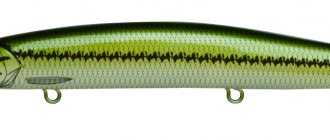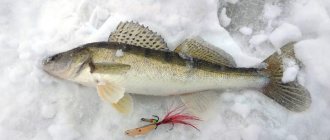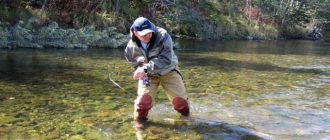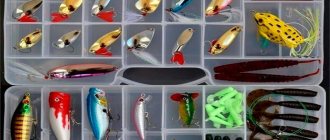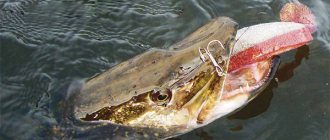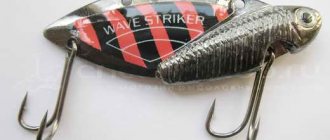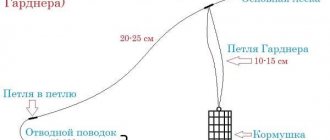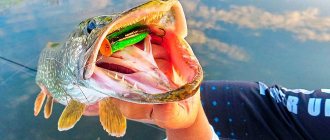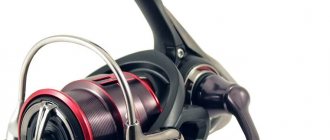Spinnerbait is an artificial fishing bait for catching predatory fish using a spinning rod. The name spinnerbait comes from the English words “spinner” - rotating spoon and “bait” - bait. A spinnerbait is a combination of a spinner bait and a jig head. The spinnerbait was invented by American anglers for catching bass, but in our conditions it is successfully used by our anglers primarily for catching pike in overgrown areas of reservoirs. Let's talk about the spinnerbait in more detail.
What is a spinnerbait
A spinnerbait is a steel wire bent at an angle of about 90 degrees, with one or more rotating blades attached to the top, and a weight with a large hook and a frame of silicone fringe called a skirt attached to the bottom.
The spinnerbait frame wire, which anglers sometimes call the rocker arm, is most often made of steel with an anti-corrosion coating. Not long ago, spinnerbaits with a wire frame made of titanium wire began to appear. The wire frame of the spinnerbait should, in its rigidity, allow the spinnerbait to pass through thickets of underwater vegetation and snags. In the middle of the wire beam there is a loop through which the fishing line is attached to the spinnerbait.
One, two or more blades are attached to the upper arm of the spinnerbait. The petals of the spinnerbait correspond in shape to the petals of rotating spoons: “willow leaf”, “Indiana”, “Colorado”. The main blade of a spinnerbait is usually attached to the end of the spinnerbait frame using a bearing swivel, sometimes with a pin-type fastener. Additional blades are attached to the upper end of the spinnerbait frame through earrings and either move freely along the wire frame or are fixed in position using beads or bushings.
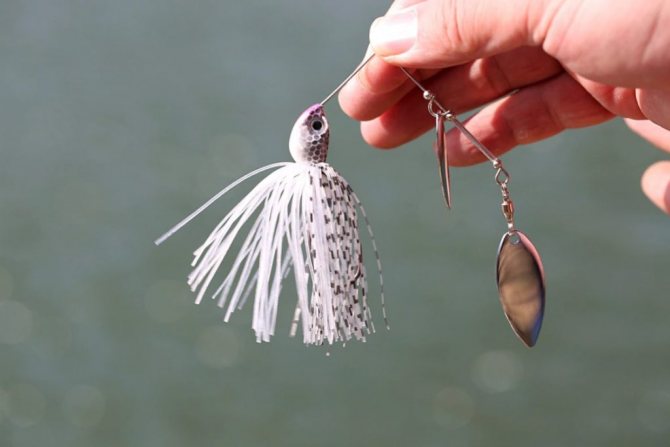
A streamlined weight with a large single hook is attached to the lower part of the spinnerbait frame. Sometimes the load is shaped like a fish's head with clearly visible eyes. The load, in any case, must have a streamlined shape in order to pass well through underwater obstacles. The hook of the spinnerbait is rigidly fixed and can be of different sizes, from 2 to 5. The skirt that covers the tip of the hook is made of silicone strands and can be of a variety of colors. The silicone skirt of the spinnerbait can be replaced with a twister or vibrotail of a suitable size.
When the spinnerbait moves in the water, the heavy head with the hook is at the bottom, and the shoulder with the petals is at the top. The petals of the spinnerbait rotate, the fibers of the skirt sway, all this attracts the attention of predatory fish.
Beginning spinning fishermen often believe that the bait should remind predatory fish of its potential prey; in fact, this is not entirely true. The spinnerbait does not look like a real live object, but is very attractive to predatory fish.
The secret of the spinnerbait’s action lies in the complex effect on the fish of sound, light, color and vibration-oscillatory stimuli, which affect the organs of vision, hearing and the lateral line of the predatory fish, forcing it to attack the spinnerbait.
How to make your own bait
Having understood the principle of operation of a spinnerbait and the algorithm for selecting the elements that make up its design, you can begin making your own bait. To carry out the work, you will need to stock up on millimeter-thick steel hard wire, a powerful single hook with a long shank, silicone slugs or an elastic model, from which you can subsequently cut pieces of material covering the hook tip, a lead blank, metal for making a petal no more than 3 mm thick and beads, which will act as limiters and buffers. The tools you should have are pliers, metal scissors, as well as equipment that will help you cast the lead mold needed to make the product.
The wire will serve as the basis or frame of the simulator. Using pliers, it is bent into something like the letter L, not forgetting to make a loop at the bending point for attaching the homemade product to the carabiner and cord. The next operation is to place a load on the short arm of the curved rocker, but first you should string the required amount of beads onto the wire to arrange the plumage fasteners. Having constructed a special matrix, lead is poured into the mold in such a way that the end of the rocker arm and the single hook are monolithically poured into the material and become a continuation of one straight line, connecting in the load.
Having arranged the loading, they begin to install the purchased or independently cut petal from tin. The petal is secured using a swivel in a loop made on the long arm of the rocker arm, or the connection is arranged according to the principle of the fastening element of a rotating spoon. Having secured the petal, all that remains is to mount the silicone or rubber tail and test the homemade product, adjusting the performance characteristics of the bait by fine-tuning the shape of the petal and the weight of the sinker.
Advantages of a spinnerbait
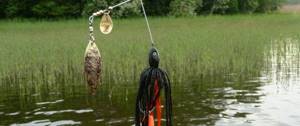
- The main advantage of a spinnerbait is its high maneuverability when fishing in thickets of vertical underwater vegetation. There are three reasons for such high cross-country ability:
- Having hooked the single hook of the spinnerbait, it looks up and is protected from snags by the wire of the lower part of the rocker.
- When retrieving, thanks to the weight on the bottom of the rocker, the spinnerbait is located in a vertical plane, which allows it to easily pass between the stems of aquatic vegetation stretching vertically from the bottom to the surface.
- Rotating petals located on the top of the rocker push the underwater algae to the sides when rotating.
- In those rare cases when the spinnerbait does wind the weeds around itself, a sharp jerk with the spinning rod is often enough to free itself from them and continue retrieving the bait.
- The spinnerbait, better than many other spinning lures, attracts predatory fish, especially when the predatory fish is active.
- Large spinnerbaits are often used by anglers without a metal leader. It’s hard to imagine a pike that could swallow a large spinnerbait whole into its mouth.
Tackle for fishing with spinnerbait
The spinning rod must be selected taking into account the characteristics of casting and retrieving this bait. There are differences compared to fishing with regular lures. The ideal solution would be a rod test up to 25 grams, and a spinning rod length from 2.5 meters.
Taking into account the weight of the bait, this tool will be the easiest to use. A sufficiently long rod allows for more convenient maneuvering, which is what we need, taking into account fishing in thickets in shallow water. Instead of regular fishing line, experienced fishermen recommend using braided line.
It is better to take a rigid leash, since this parameter does not affect the performance of the spinnerbait, unlike the same wobblers. It is important to understand that pike often attacks from the front or from below, doing this unexpectedly after some time of accompanying the “prey”. So the length of the leash should be at least 20 centimeters.
Disadvantages of a spinnerbait
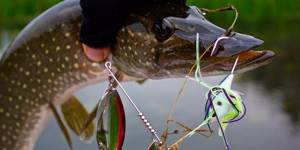
- The spinnerbait has a high windage, it is not a long-range bait, and it is quite difficult to cast it over a decent distance.
- Spinnerbaits are often severely damaged by predatory fish, especially pike. It is quite difficult to quickly replace a damaged blade; in most spinnerbaits, the blades are secured without using a fastener. In addition to the petals, the silicone skirt is severely damaged during fishing, which is almost impossible to find on the open market. If the silicone skirt is damaged, it is most often replaced with a vibrating tail or twister.
You may be interested in: Pontoon 21 GAD Harrier spinning rod
Types of spinnerbaits
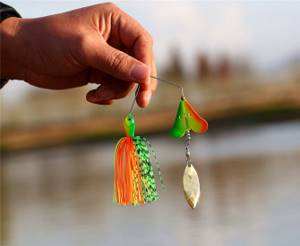
Over more than a hundred years of existence of spinnerbaits, anglers have come up with several types of this bait, differing in their design features:
- Classic spinnerbait - has one petal located in the upper part of the spinnerbait rocker arm, on the lower part of the rocker arm there is a hook and a silicone skirt.
- Double Blade Spinnerbait - A common spinnerbait design that has two working blades on the top arm of the rocker arm. Two-leaf spinnerbaits create different frequency vibrations due to different trajectories of movement of the petals, which creates vibrations in the lower part of the bait that are more attractive to predators.
- Multi-blade spinnerbaits - have three or more blades on the upper arm of the rocker. They are less common than other types of spinnerbaits. A large number of petals makes the bait even more noticeable to fish.
- Buzzbait is a type of spinnerbait in which, instead of a petal, a small propeller or impeller is installed in the upper part of the rocker arm. The propeller rotates around a wire axis and creates vibrations and oscillations that attract the attention of the pike. In addition to vibration and oscillation, the rotating propeller creates a peculiar sound, which also attracts the attention of predatory fish. As a rule, basebaits are slightly smaller in size than classic spinnerbaits; they can be used for catching both active and passive fish. The best retrieve for a basebait is a stop-and-go retrieve.
- Catchers are a type of spinnerbait, they differ from the classic spinnerbait in their lower part; instead of a silicone skirt, it has a silicone vibrotail or twister. The movements of a vibrating sieve or twister tail add to the attractiveness of the bait.
Best spinnerbaits
Booyah Moon Talker
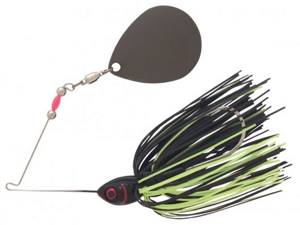
One of the largest American manufacturers of spinnerbaits. Booyah produces a wide range of spinnerbaits in different designs, sizes and weights.
Blue Fox Super Bou DC
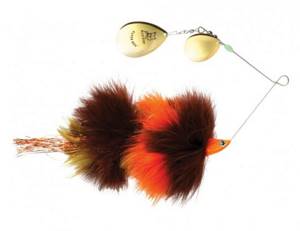
The Blue Fox Super Bou DC spinnerbait is a spinnerbait produced by the Blue Fox company, well known to anglers. The spinnerbait has two blades of the Colorado type, the wire frame of the spinnerbait is made of stainless wire, two hooks and a skirt made of marabou feathers. The Blue Fox Super Bou DC spinnerbait weighs 40 grams and is designed for catching large pike.
Spinnerbait Kosadaka Invince VX3
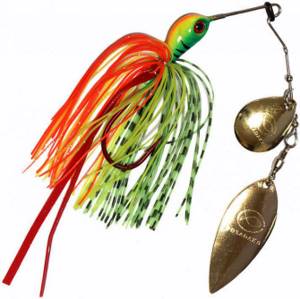
The Kosadaka Invince VX3 spinnerbait has been added to the company's product line in 2021, in addition to the Kosadaka Invince VX2 spinnerbait. The Kosadaka Invince VX3 Spinnerbait is a spinnerbait with two blades that come in silver or gold. The spinnerbait is available in three modifications with different weights: 7, 10 and 14 grams. There are modifications with different colors of the head and edge of the spinnerbait. Kosadaka spinnerbaits have a good price-quality ratio and are popular with our anglers.
Spinnerbait LUCKY JOHN SpinnerBait Shock Blade
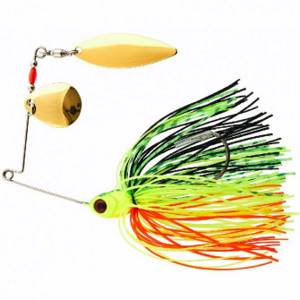
Spinnerbait LUCKY JOHN SpinnerBait Shock Blade is a spinnerbait produced by the company Salmo, well known to anglers, which produces inexpensive and high-quality fishing products under its Lucky John brand. Kosadaka spinnerbaits are low-cost and have a good price-quality ratio, which is why they are in high demand among our fishermen.
Spinnerbait Megabass V-Flat Power Bomb
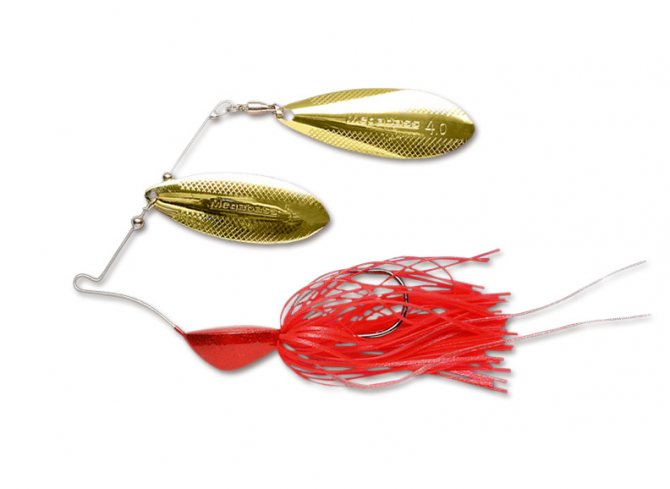
The Megabass V-Flat Power Bomb spinnerbait is produced by the Japanese fishing tackle manufacturer Megabass, which is one of the leaders in the production of highly effective spinning lures. Megabass spinnerbaits are distinguished by high quality workmanship and a high price.
Spinnerbait Lucky Craft Areas
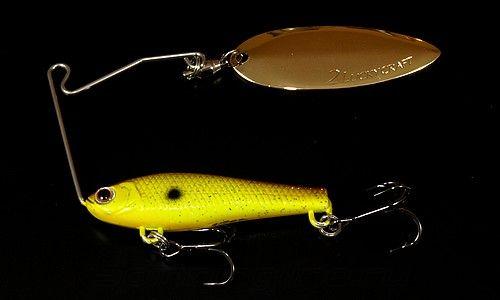
Lucky Craft is well known to anglers for being one of the largest manufacturers and suppliers of fishing lures in the American and Japanese markets. The wide range of lures produced by Lucky Craft also includes spinnerbaits of various sizes and designs. The Lucky Craft Areas series of spinnerbaits includes a large number of modifications that differ in weight (1/8 and 3/16 ounces), blade type (“Willow Leaf”, “Colorado”) and colors (6 options). They are ultralight class spinnerbaits. Lucky Craft Areas spinnerbaits were originally designed for catching rainbow trout, but have been successfully used for catching perch and small pike.
You may be interested in: DaMiKi Pirami 55S. Scout hero.
Spinnerbait Smith Spinner
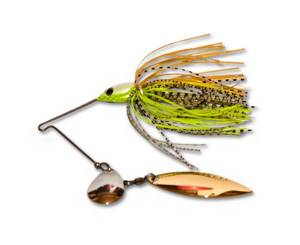
The Japanese company Smith is known to many anglers for its high-quality wobblers. The range of fishing lures produced by the company also includes spinnerbaits. Smith spinnerbaits have a super-strong frame, a super-sharp hook, and a perfectly designed head with lively eyes. The blades of Smith spinnerbaits work great even at the lowest retrieve speeds and have low drag, which makes the bait highly controllable when fishing in a variety of conditions. Smith spinnerbaits come in a variety of weights, with the most common being 1/4 and 3/8 ounce.
Tail spinner or axleless spinner. Fishing with tail spinners for perch, pike and asp
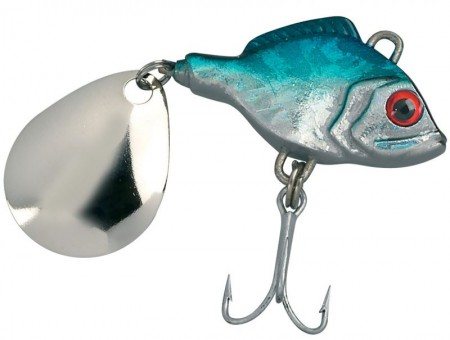
My first introduction to tail spinners was in the 1980s. In those years, my main lures were oscillating and spinning spoons. But since the arsenal of tackle was not only limited, but generally consisted of a single spinning rod, with which it was not only problematic, but in principle impossible to cast a light spinner bait far, the situation was saved by spinners additionally loaded in front. It was then that I first saw in the store and purchased baits called tail spinners.
On my first shore fishing trip, I tried long and hard to catch new baits. Looking ahead, I will say that all my efforts led to nothing. This is understandable, despite the fact that the tail spinners flew relatively far, it was still impossible to get them to the asp feeding on the surface. In addition, when the wiring slowed down, they immediately went into the lower water horizon and often came into contact with the bottom, collecting vegetation and bottom debris. The fast, even retrieve did not interest the perch either.
As a result, after several fishing trips, my tail spinners ended up in the closet on the far shelf.
I came across these baits again when I went with a friend to a fisherman I knew to catch a large chub on the Volgograd Reservoir. Imagine my surprise when Mikhail started fishing with tail spinners! According to him, they also perform well when catching other predatory fish. I also caught a few things with tail spinners, but I can’t say that they hooked to such an extent that they would take a special place in boxes of fishing lures.
Finally, during the Nizhny Novgorod fishing exhibition, at one of the stands I saw branded tail spinners from the Japanese manufacturer Viva. Needless to say, the quality of the lures, as always from the Japanese, turned out to be at the highest level. I purchased several pieces at once in different colors, sizes and different weights. It turned out that other manufacturers also have something similar, but for some reason each company called these baits differently.
If the Viva baits purchased at the exhibition were called Kozo Spin, then Lucky Craft had the name Spinboard, and Strike Pro called them Micro Whaker 30. But, be that as it may, it is always a heavy compact body, to which it is attached in the tail section through a swivel. petal. Some manufacturers attach the petal not through a swivel, but using a bow, like in conventional spinners. But some homemade tail spinners have a body very similar to the most common ice fishing balancer. I purchased what I could from branded catalogs, and made some with my own hands. More precisely, I converted it from ordinary balancers.
So why is this class of bait interesting and what kind of fish can you catch with tail spinners? Without exaggeration, they can be classified as universal baits, but still, their main and most important purpose in the conditions of the Cheboksary Reservoir, in my opinion, is perch fishing.
If fishing is done from a boat, our possibilities expand significantly. Catching perch, as a rule, takes place on sandy rifts, where we use the jig method as the main feed, i.e. a real stepped retrieve. And here, unlike coastal fishing, we don’t have to worry about losing the bait on the hook - as a rule, the bottom on such riffles is clean.
Very often, seagulls serve as an indicator of the presence of fish on a riffle. If we see a gull, there is no doubt: either an asp or a perch is chasing a fry. In our case, it doesn’t make much difference which fish feeds. After all, the perch is where the asp is, and the pike is where the perch is. In other words, having found an asp boiler and approaching it in a boat, we carefully, and most importantly, quietly anchor the craft. If the asp is on the surface, rest assured that the perch is below, which means that the tail spinner fed by the step will not be ignored. Bites do not happen on every retrieve, we have several contacts during one retrieve: the fish follows the bait, pokes it and attacks until it ends up on the hooks of the tee.
By the way, if there are still concerns that in a particular place the bottom of the reservoir is not very clean and you can get caught and lose the bait, it is more advisable to change the treble hook of the tail spinner to a double one, equipping it in such a way that the hooks of the double are oriented towards tail part of the bait. This equipment reduces the number of hooks significantly.
But we are not always able to find a perch along with an asp, focusing on seagulls or splashes on the water. Even if everything is calm on a riffle, it is still useful to fish for it. And under no circumstances should you despair if there were no bites on the first cast. If it becomes clear that the perch is not attached to the fry, I fish the riffle using a fan method. This is the only way to find and catch fish.
And in the future I constantly adjust the casting direction, trying to track where the school of perch is moving. It should be noted that there is one more interesting factor, in my opinion: as a rule, much larger perch are caught on tail spinners. In any case, last year I caught disproportionately more large perch (from half a kilo and above) with tail spinners than in previous years with other baits. In addition, he broke a record by catching a perch weighing 1320 g in the Cheboksary Reservoir.
Let us remember again that where the perch is, there is an asp. Stepped wiring of a tail spinner is more appropriate when fishing for perch. But at the moments when this bait breaks through the water column after splashdown, asp bites often occur.
And there is an explanation for this. The petal of a tail spinner operates during any stage of the retrieve, including during its free fall. It is then that the petal comes into play, attracting the asp. But still, catching a sheresper, purposefully relying on a bite at the moment the bait falls, is not entirely correct.
But nothing stops us from using the so-called pelagic jig. After casting, give the bait 2-3 seconds to sink into the water column. Then we make several turns with the reel and at the same time raise the tip of the rod upward, trying to produce something similar to a jig step, only without contacting the bottom, but in the water column.
You can also use wavy wiring. Unlike pelagic jig, during wave-like wiring, I eliminate the free fall of the bait and remove pauses.
And another argument in favor of a tail spinner when catching asp is its range. Despite the fact that tail spinners are inferior in casting range to jig-like spoons, they outperform various types of bulky baits, be it wobblers or top waters. And in this case we use light class tackle, and this greatly increases our emotions from catching a large fish.
For tail spinners weighing up to 12 g, I used the SL Rods Atria 702L series spinning rod. Excellent sensitivity allowed me not only to track the contact of the bait with the bottom and any contact with the fish, but also, importantly, I saw the whip and felt the play of the petal at all stages of the retrieve. Among other things, the rod has a decent holding power, which I was repeatedly convinced of when a pike was hooked.
In my opinion, it is undesirable to purposefully catch pike with tail spinners only because our tackle is not equipped with a steel leader. To the main eight-strand cord measuring 0.8 PE, I tie a fluorocarbon leash, invisible in the water, with a capacity of only 8 liters with a clasp at the end. Such equipment cannot withstand the sharp teeth of a predator. Practice shows that when fishing for perch on the riffles, the pike that controls these places comes out to hunt and attacks either the bait or the perch caught on the tail spinner.
In most such cases, the fight ends in favor of the pike. If we still want to catch pike with tail spinners, we must follow some rules. Firstly, it is necessary to change light-class tackle to more powerful ones, where the use of a steel leash is considered the norm.
Accordingly, tail spinners should be significantly heavier. If in the light class the weights of these baits range from 3.5–12 g, then when fishing with medium-power gear it is necessary not only to increase the weight of the baits, but also to change the fishing location from shallow riffles, say, to channel edges. In these cases, a bait with a double will be in a more advantageous position than with a tee, and its passage along snags will be better.
In the same way, you can catch pike perch and bersh using tail spinners. All that remains is to find baits weighing 20 g and above. The fact is that not many manufacturers offer original tail spinners in such weights. And here I went my own way, that is, winter balancers served as the basis for tail spinners, only they were much heavier and, accordingly, larger in size than those we talked about above. I purchased several baits weighing from 20 to 36 g, cut off the front hook with wire cutters, and put a swivel on the rear hook, at the end of which I attached a petal through a winding ring. Using this installation, we can experiment not only with the size of the petals, but also with their shape.
I don’t know if such lures can be called tail spinners, but, in my opinion, we, in principle, did not violate anything. There is a heavy body, a double or tee is attached to the bottom, and a petal is located in the tail part. The only difference from the classic is an additional hook in the tail. But here, too, practice shows that this is not at all an unnecessary attribute, since very often the predator is caught precisely by the rear single hook of the bait.
Someone will ask: why such difficulties, because pike perch and bersh can be successfully caught with classic jig baits. And I agree with this, but only half. If the fish is active, yes, it can be caught with classic baits, but when the activity of the pike perch drops, the tail spinner often finds itself out of competition.
My partner and I repeatedly conducted experiments: one fished with a classic jig, the other at the same time in the same place with homemade tail spinners, and we held the baits parallel to each other. And in order not to violate the purity of the experiment, they changed places after several casts. In most cases, the predator fell for the tail spinner, leaving other baits unattended. The main part of the bites occurred right next to the boat, that is, when the tail spinner, due to the strength of the current, hung on the next step for a much longer time than other jig baits.
Of course, the use of such baits in “strong” areas of the reservoir is unacceptable. No matter how much we protect ourselves from snags, an open rear hook will sooner or later find something to snag on. Sometimes unhooking helps to save the bait, but after that you always have to change the place of fishing.
It is no coincidence that I put this fish in last place on the list, since I have repeatedly purposefully tried to catch the bigheaded fish using tail spinners. Moreover, I tried to catch it quite closely with different bait deliveries. I used both uniform and stepped retrieves, and offered pelagic jigs to the chub, but all to no avail. Unlike perch or asp, the bighead did not appreciate these baits, and all catches were sporadic.
In a place where they mainly catch chub, unexpectedly for the locals (and how unexpected for him!) I managed to successfully bathe a homemade tail spinner. While I was adapting with its help (so as not to carry out reconnaissance with a chub cicada) to shallow depths and bottom differences, small shell rocks with “garlands”, current and other features, I experienced a couple of bites that I no longer regretted the excessive safety margin of the spinning rod. I had to work hard and be persistent, staying in this place for an hour and a half.
Everything turned out to be not in vain. A cut of braid on the shells, a break on the fish (fortunately, I made enough tails), but finally, the first troublemaker - a quite decent-sized pike perch - on the shore. Further - more: the second trophy was a pike, which offered good resistance. In vain I was annoyed after the break on the fish that I never found out/saw who was there: this pike had my tail, which had been torn off earlier, in its mouth!
Locals from the other side joked later, surprised at this catch: “Well, you put on a show there!” Of course, it’s one thing to have a chub weighing up to a kilo, and another thing is to have decent-sized teeth that are unexpected for the place.
Once again I am convinced:
1. A tail spinner, even (and especially) a homemade one, is an excellent scout in unfamiliar places (I was fishing on a visit many kilometers from home). 2. With a small single hook with the tip oriented upward, such a tail passes various types of obstacles well, although it certainly increases the number of large fish coming off. 3. A tail spinner of this design (quite long, including “Cheburashka”, rings, hook, spinner, petal) works well with both uniform and other types of wiring. 4. The petal size of the tail spinner is a COUPLE OF CENTIMETERS!!! quite enough to attract fish for two kopecks!
PS The chub nearby, as I found out later, went for everything: a tail, a spinner spoon, a cicada, a very “primitive” rubber frog... But that’s what I have. And the local “pro” of the most “pre-beach” type showed his class with a Chinese wobbler, beating me to a chub with a devastating score of about 6:20. While I persistently and principledly “tormented” each of the baits in turn until I caught the first chub, Gena caught several at a time without much strain.
For me, a tail spinner is, first of all, a universal bait that catches ALL predatory and conditionally predatory fish in the Volga. Moreover, we are not talking about accidentally catching “whites”, as in jigs, but about targeted fishing... I probably didn’t catch only catfish and ide with them. Pike-perch, perch, pike, chub, asp, even caught gobies. The tail spinner mows down EVERYONE, you just need to make minimal changes to the wiring.
Active fish are much less attached to the bottom than is commonly believed. More than once I have found myself in a situation where at a party a pike perch is rummaging around in a ten-meter depth and you can’t get it with a jig, and you still can’t get it with a wobbler. Chub, asp, perch are also explorers of the river depths.

Let's start making a simple and catchy tail spinner; we will need a petal from a spinner, a tee, a swivel, a silicone twister and a piece of tube.
On the forend of the tee we place the body of the twister without the tail. In size - so as not to interfere with hooking. Tee for a collapsible Cheburakh: the weight can always be changed.
We attach a swivel to one of the hooks of the tee, between the two tubes with clamps placed on the bend. It doesn’t move like that, the main thing is to choose the tubes.
At the other end of the swivel, through the winding ring, we place the petal. It’s better to take a petal for the tail spinner “Aglia Long”, but “Aglia” also catches. As a result, you can change the weight of the Cheburashka and the petals and body of the twister by color.
Tested by me personally - the homemade tail spinner catches perfectly.
Read other articles, reviews and testimonials:
- Review of the Ayashi Kegon New spinning rod. Reviews from fishermen about the Ayashi Kegon New spinning rod
- Review of Williams Wabler spinners
- The best spinning rods for twitching wobblers. Inexpensive and proven spinning rods
- Review of the Favorite ShotGun spinning rod. Reviews from fishermen about the Favorit Shotgun spinning rod
- Review of the Kosadaka Orange Twiching Point spinning rod. Reviews from fishermen about the Kosadaka Orange Twitching spinning rod
Buzzbait Deps Huge Buzzbait Cracker
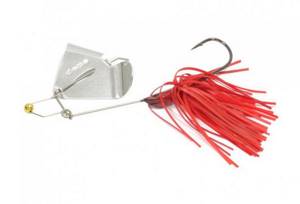
The Deps Huge Buzzbait Cracker is an excellent bait for catching trophy pike. Large pike love to hunt for fry in shallow waters overgrown with dense vegetation. In such conditions, buzzbaits allow you to literally wade through vegetation, luring pike out of hiding with powerful vibrations and a sound reminiscent of buzzing. The Deps Huge Buzzbait Cracker is 13 cm long and weighs 28 grams. The bait works best on a slow, even retrieve.
Tackle for fishing with spinnerbait
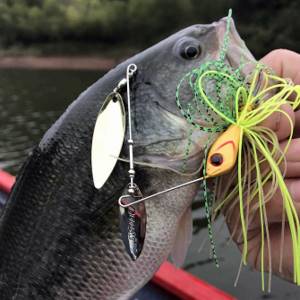
Fishing with a spinnerbait requires the angler to have gear adapted for such fishing. For spinnerbait fishing, a medium action spinning rod is best suited. For fishing from a boat, its optimal length is 2.1 meters; for fishing with a spinnerbait from the shore, the optimal length of the rod is 2.7 meters. Such a fairly long rod allows you to conveniently maneuver the spinnerbait when fishing in shallow waters and in thickets of vegetation. The upper limit of the spinning test for fishing with a spinnerbait should be about 28 grams.
The spinning rod is equipped with a spinning reel of 2000-3000 units in size, on the spool of which a braided line with a diameter of 0.15 mm is wound.

A prerequisite for fishing with a spinnerbait is the presence of a 20 cm long metal leash that can withstand sharp pike teeth. A 20 cm long leash is needed because pike can attack the spinnerbait from any side: from below, from the front or from the side. The leash, when fishing with a spinnerbait, does not have to be soft; the bait is well controlled even on a hard steel leash. A hard leash does not affect the performance of a spinnerbait, unlike wobblers.
You definitely need a swivel on the leash to prevent the thin braided line from twisting. A carabiner placed on a leash next to the swivel will allow you to quickly change the bait. The loop on the spinnerbait rocker can be open or closed (rolled into a ring). A spinnerbait with a closed loop is fastened with a carabiner, a spinnerbait with an open loop is tied with a Palomar knot.
Spinning rod and reel for spinnerbait fishing
Typically, fishing with a spinnerbait is carried out on overgrown reservoirs where long casts are not required. Therefore, they use medium and batten rods with a length of 2.4 to 2.7 meters with a test weight of up to 20 grams. When fishing for pike perch and large pike, use a heavyweight of the same length with a weight of up to 35 grams. The action of the rod is usually medium hard.
A reel with a spool capacity of 2000 to 3000 with a braided line with a diameter of 0.1-0.16 mm, depending on the fishing object, is attached to the spinning rod. When fishing for pike, use a metal leash.
Where and when to fish with a spinnerbait
Spinnerbait refers to non-snagging spinning baits. It is designed for fishing in shallow waters overgrown with underwater vegetation and deep snags.
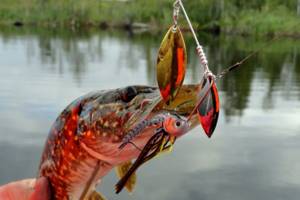
Pike love to set up their ambushes in such places, hiding in thickets of reeds, among algae, waiting for their prey. The use of other types of bait leads to either the inability to catch at all, or to very frequent snags. A spinnerbait often comes to the rescue in such conditions. Its very design was created for successful fishing for predatory fish in difficult places, replete with underwater obstacles. The upper shoulder of the spinnerbait pushes aside obstacles, serving as a kind of bumper, the petals push apart obstacles that arise along the way, the rigidly fixed hook is protected from snags by the skirt.
The best time for fishing with a spinnerbait is summer, when places in reservoirs that are promising for pike fishing are covered with aquatic vegetation, which prevents fishing with other types of spinning lures. A spinnerbait is used to catch pike in shallow bays, toad ponds and in a variety of pike reservoirs near the borders of reed thickets. You can fish with a spinnerbait in snagged areas of reservoirs, near trees that have fallen into the water, where pike often set up their constant ambushes.
You may be interested in: Som
Where and when to use a spinnerbait for pike?
The spinnerbait shows the best results in the summer. In summer, pike concentrate in shallow areas with aquatic vegetation, where the use of this type of artificial bait is most appropriate.
A spinnerbait for pike should be used in the following places:
- Backwaters and oxbow lakes with small and medium depths;
- Channels, branches, branches from the riverbed;
- Places where streams and tributaries flow into the river;
- Coastal zone in the seagrass area;
- Extensive shallow areas with algae and aquatic vegetation.
In cold water, the spinner shows weak and unstable results . It makes no sense to use bait in early spring or in the second half of autumn. The exception is shallow-water toad grasses and swamps, where only from the moment the algae die off does the toothy predator begin to bite.
Posting a spinnerbait
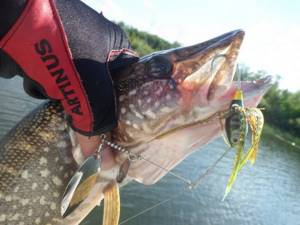
The spinnerbait is a simple bait in terms of its presentation. There are several types of retrieves that can be used when fishing with a spinnerbait:
- Uniform retrieving - the simplest of spinning reelings, consists of uniform rotation of the spinning reel handle. When fishing with a spinnerbait, the speed of the uniform retrieve should be medium or minimal. When the spinnerbait moves in the water, the movement of the bait is constantly interrupted by stops due to snags on underwater vegetation and impacts on snags, which makes the retrieve even more attractive to the predator. When the predator is highly active, uniform retrieval at medium and high reeling speeds is quite sufficient for fishing with a spinnerbait. Uniform wiring is good when fishing from a boat or a steep bank.
- Wave-like retrieving - when reeling in the fishing line, the bait moves in the water at a variable speed, for this, immediately after casting the bait, they begin reeling in the fishing line, after 3-4 meters of the bait’s movement, the reeling speed is slowed down, and after 2-3 meters it is accelerated again. A predator's attack most often occurs when the reeling slows down. Wave-like wiring is used to catch a passive predator. You can diversify the wavy wiring with shaking.
- Shaking is making sharp and jerky movements with the tip of a spinning rod while reeling in the fishing line. At the same time, the spinnerbait makes the same sharp and impetuous movements in the water, provoking the predator to attack the bait.
- Jigging is a classic jigging step, when the spinnerbait touches the bottom during a pause in reeling in the fishing line.
- Stop-and-go - similar to a step jig, but the spinnerbait does not touch the bottom when retrieved. Similar to wavy wiring.
How to improve your spinnerbait
Much attention must be paid to the shine of the material from which the petal is made. It is best to cover it with a layer of varnish. This will be very useful when fishing in opaque water. An alternative to a silicone skirt can be a simple vibrating tail . Attaching the vibrotail to the hook is done in the same way as putting on a simple fishing head. You can replace the vibrating tail with a piece of edible rubber.
When fishing with a spinnerbait, the shape of the rotating blade plays an important role. It usually has the shape of a circle. Such a petal will be able to raise the spinner in the water and make it more effective at shallow depths. The petal, shaped like a willow leaf, turns out to be quite narrow. This bait moves well in the water. It must be used when fishing at great depths.
The spinnerbait performed well when catching zander, perch and pike. The bait helps to lure predatory fish out of flooded trees and underwater plants. To make a spinner you do not need to use very many materials and tools. A spinner is a fairly catchy bait, so such a homemade device will help any fishing enthusiast provoke a predatory fish to attack, and will always allow him to return with a big catch.
Catching pike with a spinnerbait
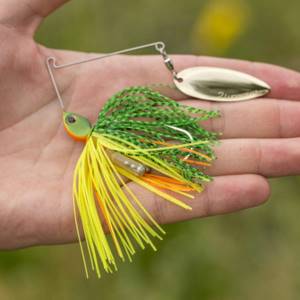
When catching pike with a spinnerbait, a spinnerbait with two silver petals and a white skirt shows good results. This spinnerbait is especially good at catching active pike. For catching passive pike, a spinnerbait with one blade is better suited.
When catching pike with a spinnerbait, good results are achieved by using a wave-like retrieve, during which the petals of the spinnerbait rotate alternately, and the skirt of the spinnerbait makes movements similar to the contraction of the tentacles of an octopus.
Fishing with a spinnerbait
Spinnerbaits appeared in our area much later than classic spinners, but they have already established themselves as excellent baits and have gained recognition from many spinners.
Spinnerbaits differ from other lures not only in their very original, even exotic design, but also in their excellent maneuverability in difficult areas, which conventional spinners and spinners cannot boast of.
Also note that, compared to various silicone non-hook baits, spinnerbaits have a greater range of action, that is, with their larger body and action they are able to attract predators from a longer distance.
Where to fish with a spinnerbait
Spinnerbaits are used primarily in spinning fishing in small areas of reservoirs with an abundance of aquatic vegetation. It is in overgrown shallow water that pike are often caught standing there in cover.
Often spinnerbaits are effective when fishing at depth, but also close to the shore. It is worth looking for large predators in pits with snags.
Spinnerbaits are characterized by high windage, which is why it is unlikely to be possible to make truly long casts.
However, they are not particularly needed, because these baits are good for fishing at a short distance from the shore.
Spinnerbait device
The spinnerbait consists of the following main parts:
- wire rocker;
- weight-head;
- single hook;
- rotating petals (1, 2, or 3 pieces);
- silicone or rubber “skirt”, or silicone bait.
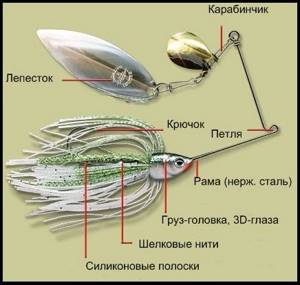
Although the general design of all spinnerbaits is the same, these lures differ from each other in the details. For example, the shape of the wire rocker may vary, the number, size and shape of metal petals, and the type of nozzle may differ.
The traditional “skirt” on the hook is often removed, and instead of it a silicone bait (worm, twister, vibrotail) is attached.
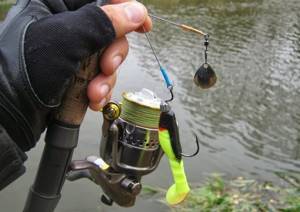
Practice shows that it is active fish who bite on spinnerbaits with two petals more often, while a sluggish, passive predator is better caught on baits with one single petal. For example, for catching active pike in shallow waters, spinnerbaits with a pair of silver petals and a light-colored “skirt” are good, and the back petal should be slightly larger than the front one.
Buzzbaits
The buzzbait is a kind of modification of the spinnerbait and differs from the latter by the presence of a small propeller instead of traditional blades.
The propeller has a lower rotation speed and creates breakers when moving. Also, during the retrieve, the buzzbait creates a characteristic noise, which attracts nearby fish. The optimal way to retrieve a buzzbait is the “Stop&Go” technique.
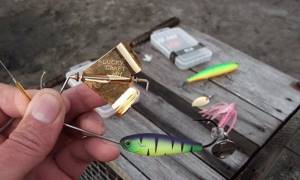
Tackle for fishing with spinnerbait
To successfully fish with spinnerbaits, you will need a fairly rigid spinning rod, which will allow for proper retrieval.
On the other hand, a stick that is too stiff makes long casting difficult, so it is necessary to find a compromise solution. If fishing occurs from the shore, then a longer rod is needed, if from a boat, a shorter one is needed. Let us remember that a spinnerbait has a large windage and cannot be cast far.
Approximate parameters when choosing a fishing rod:
- medium tuning,
- length from 2.7 to 3.5 meters
- test in 10-30 g.
There are no special requirements for the reel, the main thing in it is good reliability and a sensitive drag, the reel size is from 2500, the spool is preferably shallow. But it is better to use braided fishing line. Also, be sure to use strong leashes with a length of 13-15 cm, because most often it is the toothed pike that bites on the spinnerbait.
Leaders can be made of titanium, steel or fluorocarbon. Fluorocarbon leaders should be no thinner than 0.4mm. This will protect your line from rubbing against the sharp teeth of the pike.
Spinnerbait colors
The most popular colors for spinnerbaits are white, silver, red and black. They work well in both clear and cloudy water.
An excellent color combination for fishing in clear water is a copper petal and a yellow silicone “skirt”.
For fishing in places with an abundance of grass and algae, nickel-plated petals and spinnerbaits painted with fluorescent paints are suitable. The latter are also indispensable when fishing in very muddy water.
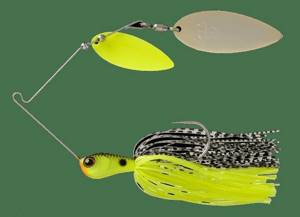
Spinnerbait review (video)
Posting a spinnerbait
An even retrieve is the main method with spinnerbaits, especially when fishing in shallow areas.
Pike are more likely to attack slow-moving bait, so the pace must be appropriate.
To avoid problems with the spinnerbait quickly sinking to the bottom, choose lighter lures with wide blades. If you plan to fish at depth, using a longer cast, you will need a spinnerbait of greater weight.
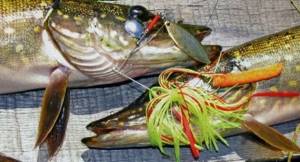
In places where the depth exceeds 1.5-2 m, try stepped wiring, to which both pike and perch can react. The use of the “step” is relevant throughout the warm season, but it brings the best results in May and September-October.

To catch active pike in the summer, they turn to surface fishing, the essence of which is the rapid movement of the bait near the surface. With such a fast retrieve, the blade of the spinnerbait leaves marks on the surface of the water that are clearly visible to the fish. Naturally, a passive predator is unlikely to chase a fast bait, but a hungry pike hunting in the upper horizon may well be interested in such a fast bait.

Also, if traditional uniform wiring is unsuccessful, you can diversify it a little with small tricks.
For example, this could be a sharp stop for literally one second, that is, after casting, you lead the bait 5-6 m, then stop abruptly and immediately continue evenly moving.
Sometimes it is precisely such a stop that provokes an attack from a predator following the spinnerbait. You can proceed according to a similar scheme, replacing sharp stops with the same sharp jerks along the course of a slow, uniform drive. In general, you need to experiment, starting from the uniform wiring of the spinnerbait.
Catching pike and perch with a spinnerbait (video)
Making a spinbait with your own hands (video)
How to make a spinnerbait with your own hands
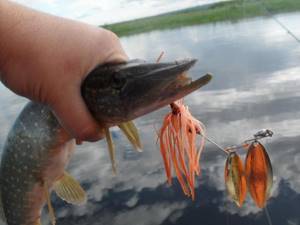
Some anglers do not want to buy a ready-made spinnerbait, but prefer to make it themselves.
In order to make a spinnerbait, you will need the following components:
- Rigid steel wire, about 1 mm in diameter
- Powerful single hook with long shank
- Silicone fibers for making a spinnerbait skirt
- Lead
- Ready-made petals or sheet metal for their manufacture
- Beads or seed beads
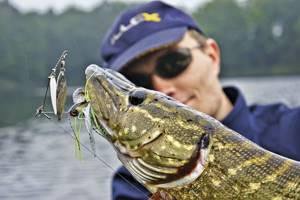
To make a spinnerbait, follow these steps:
- Using pliers, make a wire frame for the spinnerbait in the shape of the letter L, and make a loop at the bending points to attach the spinnerbait to the fishing line.
- A single hook is applied to the short end of the spinnerbait frame, the end of the frame and the hook are placed in a mold and filled with lead.
- One or more rotating blades are mounted on the long end of the spinnerbait frame. You can use ready-made petals or make them yourself from sheet metal.
- Silicone or rubber fibers are used to form the skirt of the spinnerbait, which is secured around a single hook.
The finished spinnerbait is tested in water, changing the shape of the petals and the weight of the head weight if necessary.
Tips for making your own spinnerbait
When assembling bait for pike perch with your own hands, you should never save money on the swivel, because the number of fish caught is very dependent on the free movement of the blade. It is necessary for it to start moving at the slowest speed. The petal should also work in free fall, when the spinnerbait for pike perch is lowered into the water. In order to achieve such a movement, it is necessary to use a swivel on bearings .
The spinner has a wire base. There is a petal at one end, and a special head is securely attached to the second. The hook and weight are covered with a skirt, which, in addition to luring predators, serves to protect against various snags. Additionally, large pieces of silicone can give the spinner an uneven and unique movement that causes predatory fish to chase the bait. The first bite happens very quickly.
To make a spinner with your own hands, you can use the following materials:
- stainless steel wire;
- hooks with a rather long shank;
- lead sinker;
- stainless metal petals;
- various beads for baiting predatory fish;
- swivel and two winding rings;
- To assemble the skirt, you should use regular elastic bands.
To assemble the spinnerbait you will need the following tools:
- round nose pliers;
- pliers;
- special mold for casting cargo.
